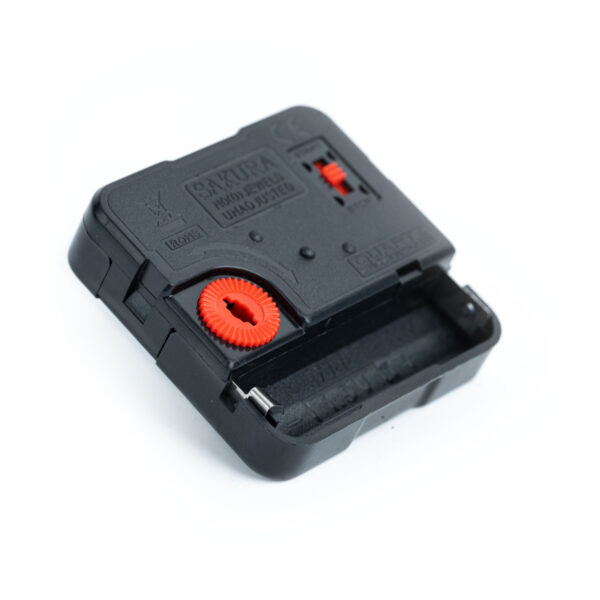Clock movement mechanisms, like the one in the image, are essential components that drive the hands of a clock to keep accurate time. Here’s a detailed explanation of how they are used:
1. Components of the Clock Movement Mechanism:
- Motor Unit: This is the main body of the mechanism, housing the motor that drives the gears.
- Gears: These are inside the motor unit and translate the motor’s movements into the rotations of the clock hands.
- Hand Shaft: This protrudes from the center of the motor unit and is where the clock hands (hour, minute, and second) are attached.
- Battery Compartment: Located at the back, it powers the motor using one or more batteries.
- Adjustment Dial: This is typically used for setting the time.
2. Installation Process:
- Mounting the Movement:
- The clock movement is usually mounted onto the clock face or base. A central hole is required in the clock face where the hand shaft will protrude.
- The movement unit is placed at the back of the clock face, with the hand shaft extending through the hole.
- It is secured in place using a retaining nut or other hardware that screws onto the hand shaft on the front side.
- Attaching the Clock Hands:
- The clock hands (hour, minute, and sometimes second hands) are attached to the hand shaft in a specific order.
- The hour hand is placed first, followed by the minute hand, and then the second hand (if applicable). Each hand typically presses onto the shaft in a snug fit.
- Setting the Time:
- The time is set using the adjustment dial at the back of the movement or by gently rotating the hands on the front. This adjusts the position of the hands to display the correct time.
3. Powering the Movement:
- Battery Installation:
- A battery (usually AA or AAA) is inserted into the battery compartment at the back of the movement.
- Once the battery is installed, the motor starts running, driving the gears that rotate the hands.
4. Operation:
- Timekeeping:
- The motor inside the movement turns the gears at precise intervals, causing the hour, minute, and second hands to move around the clock face.
- The motor’s accuracy ensures that the hands move at the correct speed, maintaining accurate time.
5. Use Cases:
- New Clock Assembly:
- Clock movements are used in the assembly of new clocks, whether they are wall clocks, desk clocks, or custom-made timepieces.
- Clock Repair:
- When a clock’s movement mechanism fails, it can be replaced with a new one, restoring the clock to working condition.
- Hobbyist Projects:
- DIY enthusiasts and clockmakers use these mechanisms in crafting custom clocks or artistic timepieces.
6. Common Types of Clock Movements:
- Quartz Movement: The most common type, powered by a battery and highly accurate.
- Mechanical Movement: Powered by a spring mechanism, used in traditional and antique clocks.
- Sweep Movement: Features a smooth-moving second hand, often used in clocks requiring silent operation.
In summary, clock movement mechanisms are vital for the accurate and smooth operation of clocks. They are used by manufacturers, repairers, and hobbyists to create or restore functional timepieces. The installation involves mounting the movement, attaching the hands, setting the time, and powering the unit with a battery, after which the clock operates independently, keeping accurate time.

Reviews
There are no reviews yet.